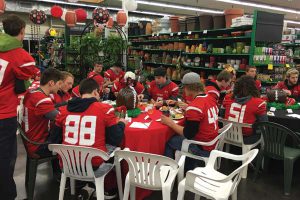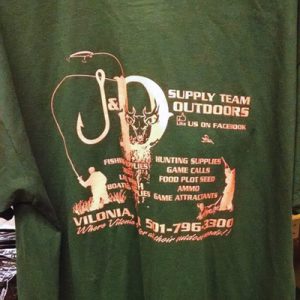To view a PDF of the story, click here. To download a press release template to help connect you with area media outlets click here.
By: Liz Lichtenberger llichtenberger@nrha.org , Jesse Carleton jcarleton@nrha.org and Sara Logel slogel@nrha.org.
Make Some Noise
Circulars, newspaper ads, TV commercials… These are all traditional methods for spreading the word about your business, methods you’ve more than likely used to bring new customers into your store. While they’ve probably been fairly successful, they cost money.
Most retailers spend about 1 to 2 percent of their gross sales on advertising and promotion, according to the North American Retail Hardware Association’s (NRHA) 2015 Cost of Doing Business Study, and the cost of traditional methods can add up quickly.
While conventional marketing certainly has its place, there are other, lower-cost ways to drive traffic into your store. Companies are taking more sophisticated approaches to integrated marketing, so consider utilizing more mainstream techniques, such as circulars, along with the suggestions we provide on the following pages to maximize your current marketing budget.
We’ll discuss four low-cost ways that can help you drive more traffic. You’ve probably tried some of these before, but we’re here to provide ideas of how you can get the most bang for your buck out of these cost-effective methods or maybe try something you hadn’t considered.
And while you can spend as much as you want (for example, community events can get costly, depending on how big or involved the event is), there are several suggestions that take nothing more than a few phone calls or an hour at the computer.
Read on to learn more about these different strategies, hear what other retailers have tried and find ways you can reach out to your customers.
Explore Unique Community Events
Getting involved in the community offers a different kind of return than traditional advertising. Whereas traditional advertising might focus on sale items, community involvement focuses on building relationships and creating a loyalty that has customers returning to the store for their regular shopping, not just a sale.
You can take these events a step further than ladies’ nights or a tax-free weekend; don’t be afraid to think outside the box.
When the local high school football team went to the state title game for the first time, Brad McDaniel, owner of McDaniel’s Do it Center in Snohomish, Washington, hosted a team dinner at his store.

“We sell Traeger grills, so we bought and grilled 100 lbs. of prime rib, and invited the team and the community to dinner and a pep rally to send the players off to state,” he says. “We probably had 300 people in the store that night. It was a lot of work, but a lot of fun.”
Once a year, J & D Supply in Vilonia, Arkansas, hosts a fall hoedown-style party for the community. Owner David Bowie shuts down the store, hires a band (of which he’s a part), brings in vendors to give away product and cooks plenty of food. “We attract several hundred people,” he says. “This event is not really about selling; we just want customers to feel comfortable and feel a part of our community.”
Not every community event organizer will come to your door asking for support; sometimes it’s up to you to be proactive in finding out what’s happening and see how you can contribute.
“We work closely with the city hall and chamber of commerce, so we know everything that is going to be happening in the area,” says Bowie. This is how he found out the local chamber of commerce hosts a home show each year, a natural fit for J&D Supply. It’s the opportunity for local businesses to show what they have to offer. Bowie uses the time in his booth for demonstrating new products and to talk about the different types of services his store offers.
Louie Potetz of Potetz Home Centers, which has two locations in Texas, goes beyond the mere cash or material donation whenever possible; he wants maximum engagement out of each transaction.
For example, one of the biggest events in the area is the county fair, and Potetz Home Center always has a strong presence there. Children who raise an animal for the fair will usually auction it off when the fair is over. Potetz always buys an animal, listing his store as the buyer. Then, he’ll donate the meat to a local non-profit, such as the senior citizens’ home, or he might bring it back to the store and serve a customer appreciation dinner.
McDaniel suggests other retailers decide in advance how much they want to donate, whether it be money, gift cards or products. This way, they can be fair in how much they give to different groups, but don’t have to worry about breaking the bank.
We’ll offer more advice and information about events you can offer to your local community, along with examples from retailers, in the June issue of Hardware Retailing.
What You Can Do
• Think beyond donations and giveaways. Set up a tent at the local farmers market, participate in city parades or offer your store as an event space for a networking night or an organization’s meeting place.
• Organize a volunteer day with your employees to get them out in the community.
• Partner with other local businesses (preferably those with a different customer base) to share in an event and split the cost. Not only does this lower the cost of the overall event, but also it draws in the customer base of that other business.
Make Your Logo Prominent
Even when you aren’t out in the community, your logo should be.
Potetz Home Center keeps a stock of items such as buckets and nail aprons with the store logo on them. They are available as low-cost items in the store, but they also make for a quick donation if an organization needs a giveaway for an event. Potetz also thinks beyond the bucket when it comes to providing creative ways to advertise with the store’s logo. He’ll give teachers in the local school wooden yardsticks and children’s pens and pencils, all emblazoned with the store’s logo.

Most of his ideas for giving back to the community come from the community itself. “We let the community tell us those areas where they feel they have a need, and that’s how we respond,” he says.
In the past, True Value of New Paltz in New Paltz, New York, created canvas bags with its logo for an event and they later became popular for giveaways and as in-store merchandise. In addition to the canvas bags, the store would provide gift bags to area organizations, which would have the store’s logo on it, says Eileen Hedley, store manager of customer relations.
Sponsoring sports teams is also a good way to get your logo out in the community, and McDaniel and his business have done their fair share of just that.
“I feel like every team jersey here in town has our logo on the back,” he says.
He also puts the sponsorship logos online so they can be seen by fans watching local sporting events over the Internet. “When anyone is watching that game online, or if someone goes back to watch it later, there’s our ad on the website,” he says.
Several years ago, Bowie sponsored a major renovation of the high school football field. The investment was substantial—nearly $30,000 over ten years—but there is a residual effect of that investment every time the team plays a game. The J & D Supply logo is always visible on the field. During the game, the announcers in the stadium regularly name the field’s sponsors, reminding the crowd to shop there.
What You Can Do
•Create merchandise with your logo on it, such as T-shirts or ball caps. Selling these items will not only expand your product offering but will also grow your brand awareness.
• Provide bumper stickers or window clings that have a fun message and include your logo.
• If you have a store vehicle, a tent you use for events or any other materials related to the store, ensure they have the store’s logo on them so it’s displayed as these items travel through town.
• Also look for vendors that will include your logo on non-promotional types of product. The most common is house wrap, but there may be other items, like caulk.
• Partner with your key contractors to create yard signs they can use at properties where they’ve finished a major project. The sign can tell the name of the contractor doing the work and list your store as the one supplying the materials.
• Find shop-local signage you can customize with your logo at TheRedT.com/shoplocal.
Buddy Up to Your Local Media
It’s a good idea to make contacts with your local newspapers, TV stations or websites and let them know you’re a home and garden expert in the community. If you aren’t sure who to contact, make a quick call to the newsroom of the local newspaper or TV stations and find out who might cover news and other happenings with your store.
Since True Value of New Paltz is the only local hardware store in town, it becomes the source of advice during weather crises, such as a hurricane or winter storm, says Hedley.
Local news stations have interviewed the store’s owner and employees on ways to prepare for these events, since the store’s employees are the in-town experts, she says.
The weather also makes McDaniel turn to the local media. “For example, it doesn’t get too hot here very often, but when it does, we will call the local media to let them know we have fans in stock,” he says. “Sometimes they’ll even put a link to our store on their web page so residents know they can come to our store if they need a fan.”
If the local media doesn’t come to you for expert advice, inform them of store events or donations.

The local newspaper frequently puts Potetz Home Center’s name in the paper when they make a notable donation. The paper gives a Spirit of Sharing award to recognize people or companies who give to those in need, and the store has received that award on multiple occasions.
When he gets the store’s name in the paper, Potetz tries to include as many names of his staff as possible. This makes the employees feel good about working at the store, and it helps the public get to know the employees too.
Bowie is fortunate that a friend of the store works at the local newspaper. He’ll send her stories, often those that feature his customers. He prefers putting photos of his customers in the paper rather than his own, although the store always gets mentioned in the article. The customers give the story more interest to the general public.
McDaniel did something similar during a recent store remodel. The store’s territory manager sent a press release to the local newspaper, which wrote a small story about the project.
“It was funny—people came in, saying, ‘I hear you’re expanding the paint department,’” McDaniel says. “I walked into the local cafe at 6 a.m. and already heard customers talking about it. People read the story and got excited about it.”
True Value of New Paltz uses the local media as an informative source any time a big event or change happens to the store. For example, the store recently added a rental department, says Hedley, and she sent a press release to the local media. She also distributes press releases prior to their annual paint event and anniversary event.
“Any time we do a larger event, I send a press release to the paper and then follow up with a phone call,” Hedley says. “Someone usually comes by and puts a write-up of the event in the paper.”
What You Can Do
• Build relationships with the local media so you become their go-to expert during weather events or changes in seasons.
• Create press releases for a variety of topics, such as reasons to shop local at your store during different holidays or the addition of new product lines to your inventory. To help you get started, we created a template that outlines the key elements of a press release. Download it at TheRedT.com/PressRelease.
• Your employees are experts on paint, gardening and a variety of other product categories; use that to your advantage. Contact your local media and offer ideas to the public, such as tips to protect your garden from frost, the newest paint trends or lawn care suggestions.
Add Variety to Social Media
One common mistake many retailers make with social media is using it to do nothing but post photos and information about products, using it as a sales pitch. Some product information is fine—it’s a great way to cross-promote the items you are advertising in your circulars. However, many customers want to see more of what’s happening at the store.
McDaniel says his store built a Facebook page early on—“back when it was still weird for a store to have one.”
He put his mom in charge of it. “She does a great job,” he says.
She posts frequently about what’s happening around the store, giving customers and followers a look at the store from an employee’s point of view.

“Instead of photos of a drill that’s on sale this week, she might take photos of houseplants and post those, along with a comment like, ‘Aren’t they beautiful?’” McDaniel says. “We posted a photo we’d taken of a cashier on her birthday, and we got plenty of comments from people asking about the plant in the background of that photo.”
Hedley runs True Value of New Paltz’s social media accounts, which include Facebook, Twitter and Instagram.
“I try to make the posts as personable and funny as possible,” she says. “I am in a lot of the photos I post, which creates a connection with the audience. They’ll see me in town or at the store and recognize me from Facebook.”
Currently the store is undergoing a renovation and has used its social media accounts to keep customers updated and informed on the changes occurring in store.
“We are focusing Facebook posts on the renovation and sharing the progress, creating a lot of excitement,” Hedley says. “People come into the store and talk with us about what they saw on Facebook,” which shows that social media is driving in-store traffic.
If you do use social media to post about promotions or sales, be careful of how often you do so. Bowie runs these on social media about once a month. “It’s important we try not to be overbearing with promotions we run on Facebook,” he says.
Recently, he used Facebook to advertise a sale on a popular line of boots, which included a discount and a free pair of socks. “Within 10 minutes of placing the ad on Facebook, we had people calling and coming in the door looking for the special,” he says.
Know your audience—it may be more suited for Facebook, or perhaps your customers are more likely to follow what you post on Pinterest. But, if it’s fitting for your customer base, try cross-promoting your content among several different platforms. For example, when McDaniel’s father recently celebrated 60 years in the hardware industry, the company added a short piece about the occasion (and information about a party to celebrate) on its website, posted about it on Facebook and included it in an email, along with sending out a text message inviting everyone to the party.
What You Can Do
• Many retailers are using social media, so make sure your accounts stand out. Post a variety of content, not just new products or promotions.
• Share photos of employees in the store, fun events that are happening, a customer’s dog or anything that adds a personal touch to your social media accounts.
• To download a social media toolkit that can help take your social media platforms to the next level, visit TheRedT.com/SMkit.
 Hardware Retailing The Industry's Source for Insights and Information
Hardware Retailing The Industry's Source for Insights and Information








